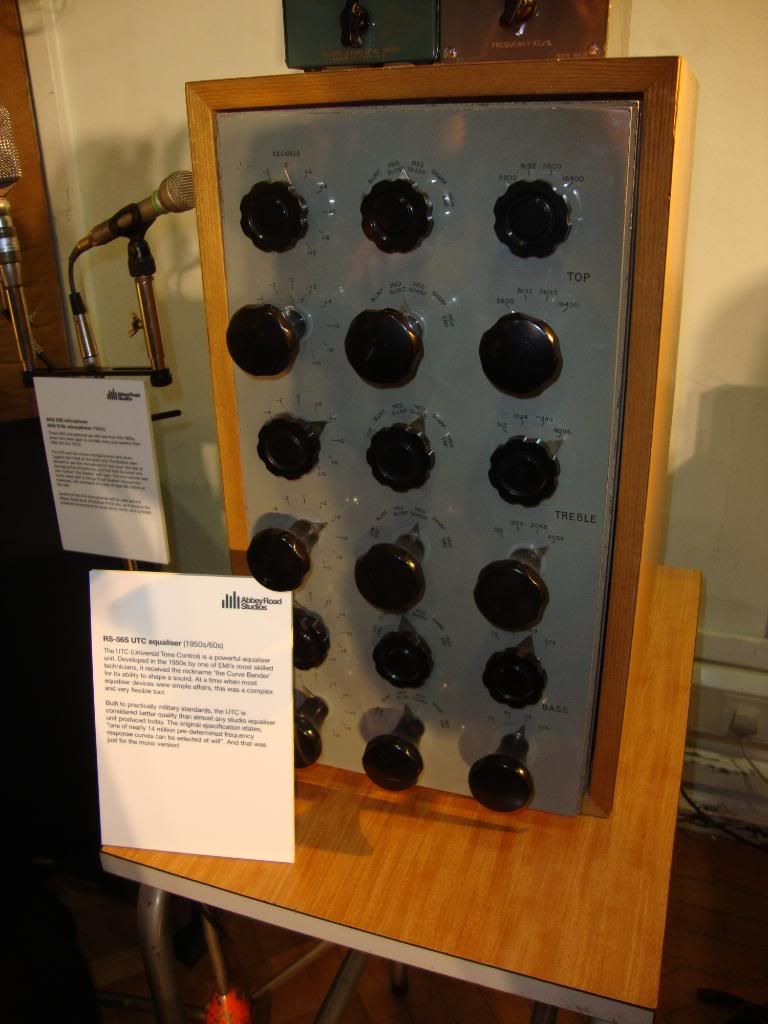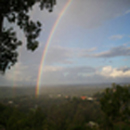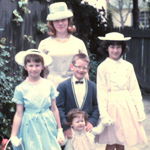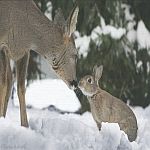I visited Abbey Road studio 2 yesterday to commererate it's 80th year.
Kevin Ryan and Brian Kehew the writers of "Recording the Beatles" did a talk.
I thought forum members would be interested, here's some pics, which include the gear that the Beatles and many other famous people used.
Winifred Atwell/Russ Conways piano etc.
If anyone has any question please feel free to ask.
http://s289.photobucket.com/albums/ll20 ... EY%20ROAD/
Phil
ABBEY ROAD VISIT
13 posts
• Page 1 of 2 • 1, 2
Re: ABBEY ROAD VISIT
Man....talk about walking on Hallowed ground!!! I would give my left (fill in the blank) to see that place!! How did you hear about the tour and talk that was given?
SteveT
SteveT
-

SteveT - Premium Member

- Posts: 54
- Joined: Thu Jan 20, 2011 1:33 am
Re: ABBEY ROAD VISIT
Hi Steve,
I got an email, I am on the "Recording the Beatles" data base. The first talk session tickets were sold out in minutes, they added a few more sessions which also were sold out, but one morning another email came through and my finger went straight to "BUY"
Standing on the spot where they all played, the same wood block floor, the atmosphere was electric and the acousics even in such a large space was perfect.
Half way through the talk it was requested that three guys who could play a piano came to the front. A guy next to me was one and from Wales. They were asked to play an E chord on the three piano's there. After a count of four they all hit the chord, it was the one at the end of "A day in the Life". There was dead silence in the studio and that chord rang on and on, I have to admit that it was very emotional!
The Welsh guy was thrilled to bits but was even more exited when I told him that on the original recording, the three studio Grands were used, he was the only one out of the three playing one of them!
Phil
Here's some details. They are 1000 pixels each, only half the pictures are shown
This two track 1/2" was used in the 50's and sixties, all the experimental stuff was done on it, flanging etc.

The J37 four track used by the Beatles.

The REDD 17 predecessor of the 37 which was used to record the Beatles etc. The 1930's eq desk with it's huge knobs.

The Fairchild and Altec compressors know as the Shadows, Beatles etc secret device.

The TG desk used on the Abbey Road album and Dark side of the Moon.

Mike tester, made by Abbey Road technicians to set up mics when for example micing up orchestras with multiple mics. It saved doing the 123 testing thing.
The rod in front is to set the correct distance to the mic, then a buuton is pressed which produces a hissing sound which is calibrated in the control room.

Used on "A Day in the Life" and others.

Used by the Beatles etc, also detuned for Winifred Atwell for her Honky Tonk sound, and also Russ Conway.

The keys where full of grime, the ivory is missing with centre ones.

As close as I could get to the control room!

Taken from the top of the steps. The far left corner was where all the music was made.

EQ Boxes.

To the right of the screens at the bottom of the stairs, behind the wall, is where the original control room was located.

This 50's equaliser was called the "Curve Bender" behind the front plate was a series of big coggs connecting the other knobs, it looked like a inside of a grandfather clock.

I got an email, I am on the "Recording the Beatles" data base. The first talk session tickets were sold out in minutes, they added a few more sessions which also were sold out, but one morning another email came through and my finger went straight to "BUY"
Standing on the spot where they all played, the same wood block floor, the atmosphere was electric and the acousics even in such a large space was perfect.
Half way through the talk it was requested that three guys who could play a piano came to the front. A guy next to me was one and from Wales. They were asked to play an E chord on the three piano's there. After a count of four they all hit the chord, it was the one at the end of "A day in the Life". There was dead silence in the studio and that chord rang on and on, I have to admit that it was very emotional!
The Welsh guy was thrilled to bits but was even more exited when I told him that on the original recording, the three studio Grands were used, he was the only one out of the three playing one of them!
Phil
Here's some details. They are 1000 pixels each, only half the pictures are shown
This two track 1/2" was used in the 50's and sixties, all the experimental stuff was done on it, flanging etc.

The J37 four track used by the Beatles.

The REDD 17 predecessor of the 37 which was used to record the Beatles etc. The 1930's eq desk with it's huge knobs.

The Fairchild and Altec compressors know as the Shadows, Beatles etc secret device.

The TG desk used on the Abbey Road album and Dark side of the Moon.

Mike tester, made by Abbey Road technicians to set up mics when for example micing up orchestras with multiple mics. It saved doing the 123 testing thing.
The rod in front is to set the correct distance to the mic, then a buuton is pressed which produces a hissing sound which is calibrated in the control room.

Used on "A Day in the Life" and others.

Used by the Beatles etc, also detuned for Winifred Atwell for her Honky Tonk sound, and also Russ Conway.

The keys where full of grime, the ivory is missing with centre ones.

As close as I could get to the control room!

Taken from the top of the steps. The far left corner was where all the music was made.

EQ Boxes.

To the right of the screens at the bottom of the stairs, behind the wall, is where the original control room was located.

This 50's equaliser was called the "Curve Bender" behind the front plate was a series of big coggs connecting the other knobs, it looked like a inside of a grandfather clock.

-

Phil.c - Premium Member

- Posts: 1114
- Joined: Sun Nov 23, 2008 10:58 pm
- Location: South Wales
Re: ABBEY ROAD VISIT
Phil,
Really showing my age here, but I once owned eight (8) of the BTR machines and used two of them on a daily basis. They were a great machine, once you got the fork-lift truck to move them.
For the "young pups" among us, they had three 5HP motors, that were bolted to the bottom of the case and had long extension arms reaching up to the deck and the fast forward/rewind, was the fasted of any machine I have ever seen, but god help you if the tape decided to fly off the spool (a flat tray) --- I can tell a very funny story about this happening at a radio station during what was supposed to be a"live" broadcast.
Oh for the good old days!!!!!!!!!
David
Really showing my age here, but I once owned eight (8) of the BTR machines and used two of them on a daily basis. They were a great machine, once you got the fork-lift truck to move them.
For the "young pups" among us, they had three 5HP motors, that were bolted to the bottom of the case and had long extension arms reaching up to the deck and the fast forward/rewind, was the fasted of any machine I have ever seen, but god help you if the tape decided to fly off the spool (a flat tray) --- I can tell a very funny story about this happening at a radio station during what was supposed to be a"live" broadcast.
Oh for the good old days!!!!!!!!!
David
-

csp - Premium Member

- Posts: 679
- Joined: Mon Dec 15, 2008 4:00 am
- Location: Gold Coast region, Queensland, Australia
Re: ABBEY ROAD VISIT
Phil,
Fantastic!!!! That's just amazing. Great shots! Thanks for sharing them and the story. I'm completely envious but also thrilled for you. What a wonderful experience. Congratulations!!!
BTW, all we have to do is right click on the image and select View Image (Firefox) or Open Image In a New Tab (Safari) and we see the entire photo.
c-ya,
Dan Worley
Fantastic!!!! That's just amazing. Great shots! Thanks for sharing them and the story. I'm completely envious but also thrilled for you. What a wonderful experience. Congratulations!!!
BTW, all we have to do is right click on the image and select View Image (Firefox) or Open Image In a New Tab (Safari) and we see the entire photo.
c-ya,
Dan Worley
-

Dan Worley - Premium Member

- Posts: 113
- Joined: Fri Nov 21, 2008 8:33 pm
Re: ABBEY ROAD VISIT
David, you should have kept those BTR machines.....but I think you know that 
Dan, what can I say...being there was just overwhelming, I mean, when I was there I was looking at pictures of various bands, but mainly the Beatles snapped playing the songs we all know and i'm standing on that spot and on the same wood block floor, and when that E chord rang out on the three piano's, well, words fail me!
I guess the younger guys on this forum are wondering what all the fuss is about
Phil
Dan, what can I say...being there was just overwhelming, I mean, when I was there I was looking at pictures of various bands, but mainly the Beatles snapped playing the songs we all know and i'm standing on that spot and on the same wood block floor, and when that E chord rang out on the three piano's, well, words fail me!
I guess the younger guys on this forum are wondering what all the fuss is about
Phil
-

Phil.c - Premium Member

- Posts: 1114
- Joined: Sun Nov 23, 2008 10:58 pm
- Location: South Wales
Re: ABBEY ROAD VISIT
Phil.c wrote:David, you should have kept those BTR machines.....but I think you know that
Dan, what can I say...being there was just overwhelming, I mean, when I was there I was looking at pictures of various bands, but mainly the Beatles snapped playing the songs we all know and i'm standing on that spot and on the same wood block floor, and when that E chord rang out on the three piano's, well, words fail me!
I guess the younger guys on this forum are wondering what all the fuss is about
Phil
Yeah, though I've imagined being there many times in my mind, ever since I was a young boy, I just couldn't imagine being there for real, Phil. It's just fantastic that you got a chance to do that and took advantage of it!!!
And to think it was almost sold and turned into what, legal offices or something? Ugh!!!
c-ya,
Dan Worley
-

Dan Worley - Premium Member

- Posts: 113
- Joined: Fri Nov 21, 2008 8:33 pm
Re: ABBEY ROAD VISIT
Back some years ago my good friend and studio compadre called me from Abbey Road. He was doing monitors for Mary J Blige at the time and they were doing a live broadcast from there. He said it was an amazing place, all the mics have their history written down so you know who used them for what sessions though out the years. I was envious as I had only been to the front door which was cool too but not the same as going in and doing actual work there. I'll have to see if he has some pics of the gig. I remember seeing some but I don't think I have them on a drive anymore. Good stuff here.
Last edited by Crash on Mon Mar 26, 2012 3:43 pm, edited 1 time in total.
-

Crash - Premium Member

- Posts: 1286
- Joined: Fri Nov 21, 2008 10:05 pm
Re: ABBEY ROAD VISIT
Dan, I saw plans there where Studio 1 was going to be turned into a two storey car park!
We were told that Lenny Kravits has one of the three early desks, Mark Knopler has an early desk and Paul M has now got the Mellatron in his studio.
Phil
We were told that Lenny Kravits has one of the three early desks, Mark Knopler has an early desk and Paul M has now got the Mellatron in his studio.
Phil
-

Phil.c - Premium Member

- Posts: 1114
- Joined: Sun Nov 23, 2008 10:58 pm
- Location: South Wales
Re: ABBEY ROAD VISIT
The last photos you sent me were of the street and front door... moving up to the East side are you?
Ha ha! very good Phil. AWESOME!!!
nice room huh?
Michael
Ha ha! very good Phil. AWESOME!!!
nice room huh?
Michael
Make some noise!!!
-

High C Double G - Premium Member

- Posts: 325
- Joined: Tue Nov 25, 2008 3:55 am
13 posts
• Page 1 of 2 • 1, 2
Who is online
Users browsing this forum: Google [Bot] and 63 guests